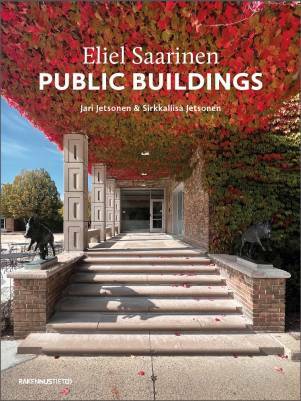A visual journey through Eliel Saarinen’s iconic public buildings

Anna Rusi
Sirkkaliisa and Jari Jetsonen’s new book presents for the first time in colour photographs Eliel Saarinen's entire career arc, also showcasing his significant work in the United States.
Eliel Saarinen (1873–1950) is particularly celebrated in Finland as an architect of the National Romantic era's iconic works. From the very start of his career, his architectural designs reflected a dynamic interplay between local and international influences. In 1923, Saarinen and his family moved from Finland to the United States. Sirkkaliisa and Jari Jetsonen’s book, Eliel Saarinen Public Buildings, showcases the architect’s most significant works from both stages of his career, in Finland and in the U.S.
Saarinen’s career began in collaboration with Herman Gesellius and Armas Lindgren. Together, the trio designed on both small and grand scales, ranging from residential and commercial buildings to major public projects. Starting in 1905, Saarinen worked as an independent architect. Under his own firm, he also embarked on his career in urban planning, spurred by his second-place finish in the competition to design Canberra's city plan. His ambitious urban planning proposals, such as those for Munkkiniemi-Haaga and Greater Helsinki, remain subjects of discussion to this day.
Eliel Saarinen's key works from the early 1900s include Helsinki Central Railway Station (1904–1919), Lahti City Hall (1910–1912), and Joensuu City Hall (1909–1914). Saarinen's influence on shaping the identity of the young Finnish state also extended beyond architecture into applied arts, as he designed Finland's first series of banknotes and postage stamps after gaining independence.
His success in the Chicago Tribune Tower competition, a subsequent trip to Chicago, and ultimately his relocation there marked the beginning of a new phase in Saarinen’s career. After having settled into a new environment, culture, and language, Saarinen was invited to design the Cranbrook campus. He was responsible for notable projects such as the Cranbrook Institute of Science (1935–1938), the Academy of Art (1925–1938), and the Art Museum and Library (1938–1942). In addition to his architectural contributions, Saarinen played an active role in developing the curriculum at Cranbrook Academy of Art, serving as a teacher and later as its director.
Working in the United States solidified Eliel Saarinen’s position as an internationally renowned architect. Saarinen's son, Eero Saarinen, began assisting his father during the Cranbrook years, contributing to various details and furniture designs. Their collaboration deepened with projects such as Kleinhans Music Hall (1938–1940), the First Christian Church (1939–1942), and the unbuilt Smithsonian Gallery of Art competition-winning design (1939). After his father’s death, Eero Saarinen continued the legacy, designing an expansion in the 1960s for Christ Church Lutheran, originally designed by Eliel in 1947–1949.
Eliel Saarinen remains one of Finland’s most internationally recognized architects. Eliel Saarinen Public Buildings highlights twenty of his projects from Finland, Estonia, and the United States, spanning fifty years. Created by architect Sirkkaliisa Jetsonen and photographer Jari Jetsonen, and published by Rakennustieto, the book offers a comprehensive and visually striking exploration of Saarinen’s long career through vibrant color photographs and original drawings. The graphic design of the book was handled by architect Miina Jutila.

Jari Jetsonen & Sirkkaliisa Jetsonen: Eliel Saarinen Public Buildings. Rakennustieto, 2024. 279 pages.
The book is available from various bookstores and Rakennustieto’s online store.
The book was launched on Eliel Saarinen’s 151st birthday in the Presidential Waiting Room at Helsinki Central Railway Station. During the same event, Damy, the patron association for the Design Museum and the Museum of Finnish Architecture, awarded its first Tulevaisuus Prize. Former Prime Minister Paavo Lipponen, a notable admirer of Saarinen’s architecture, delivered the keynote speech. Read the speech through this link.


